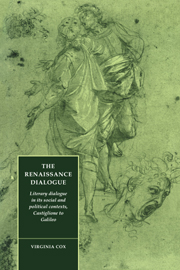 The Renaissance Dialogue
The Renaissance Dialogue Published online by Cambridge University Press: 05 December 2011
… infinita sendo la turba delle bugie, le quali adombrano le scienzie, sempre da esse con ogni cura, come da peste contagiosa, si dee guardar lo 'ntelletto
Sperone Speroni, Apologia dei dialoghi, parte terza (1571)Among the works on the poetics of dialogue which began to emerge after 1560, the only one which departs from purely formal considerations, and makes a serious attempt to deal with the cultural politics of the genre, is Sperone Speroni's Apologia dei dialoghi (1574–5). The political focus of the Apologia was partly determined by the circumstances which led to its composition: the traumatic and ludicrous fact of Speroni's dialogues being denounced to the Inquisition, and the author's subsequent, justly indignant, endeavours to clear his name. Even the most superficial reading of the resulting work, however, should be enough to convince us that its apologetic format is little more than a pretext for a work which aspires to synthesize the reflections of a lifetime. At the same time one of the century's most distinguished writers of dialogue and one of its most incisive and original thinkers on the arts of discourse, Speroni was uniquely qualified to analyse the complex phenomenon of communication by dialogue. In the Apologia, combining a practitioner's sensitivity to poetics with a cultural historian's broad diachronic perspective, he provides the best guide we have to the religious and political factors which determined the trajectory of the dialogue in late-Cinquecento Italy.
To save this book to your Kindle, first ensure [email protected] is added to your Approved Personal Document E-mail List under your Personal Document Settings on the Manage Your Content and Devices page of your Amazon account. Then enter the ‘name’ part of your Kindle email address below. Find out more about saving to your Kindle.
Note you can select to save to either the @free.kindle.com or @kindle.com variations. ‘@free.kindle.com’ emails are free but can only be saved to your device when it is connected to wi-fi. ‘@kindle.com’ emails can be delivered even when you are not connected to wi-fi, but note that service fees apply.
Find out more about the Kindle Personal Document Service.
To save content items to your account, please confirm that you agree to abide by our usage policies. If this is the first time you use this feature, you will be asked to authorise Cambridge Core to connect with your account. Find out more about saving content to Dropbox.
To save content items to your account, please confirm that you agree to abide by our usage policies. If this is the first time you use this feature, you will be asked to authorise Cambridge Core to connect with your account. Find out more about saving content to Google Drive.